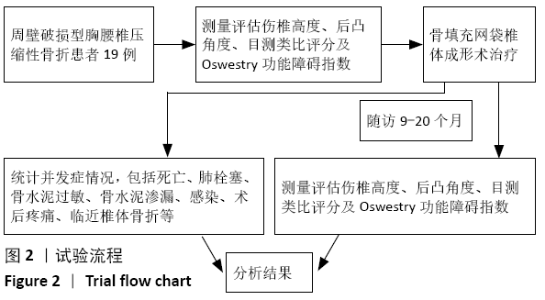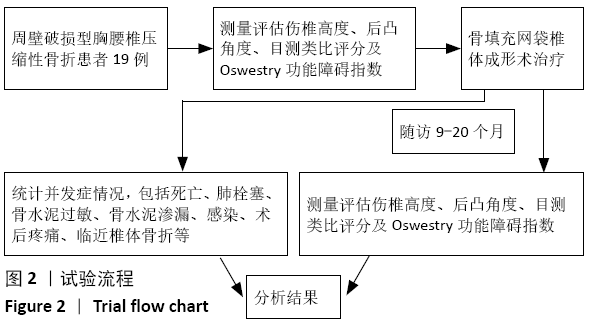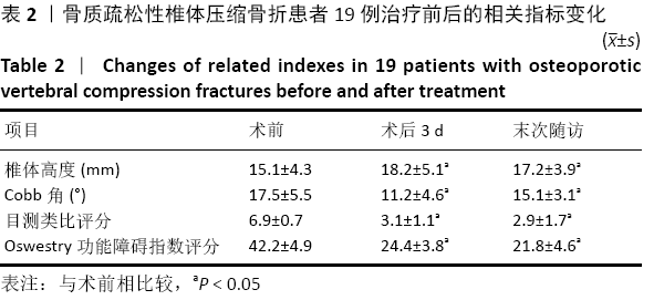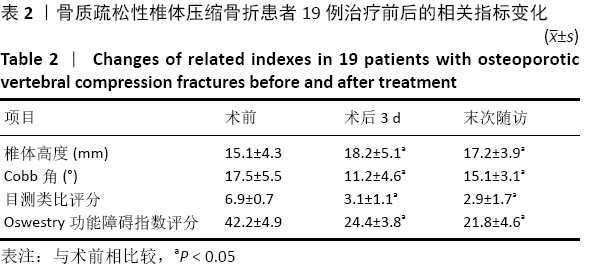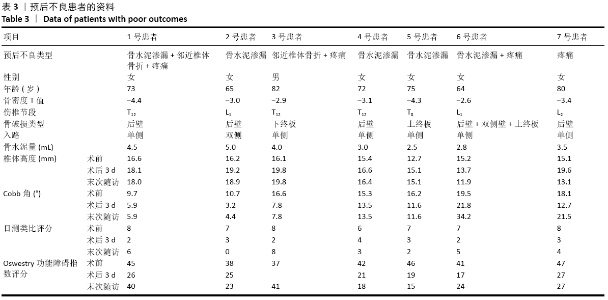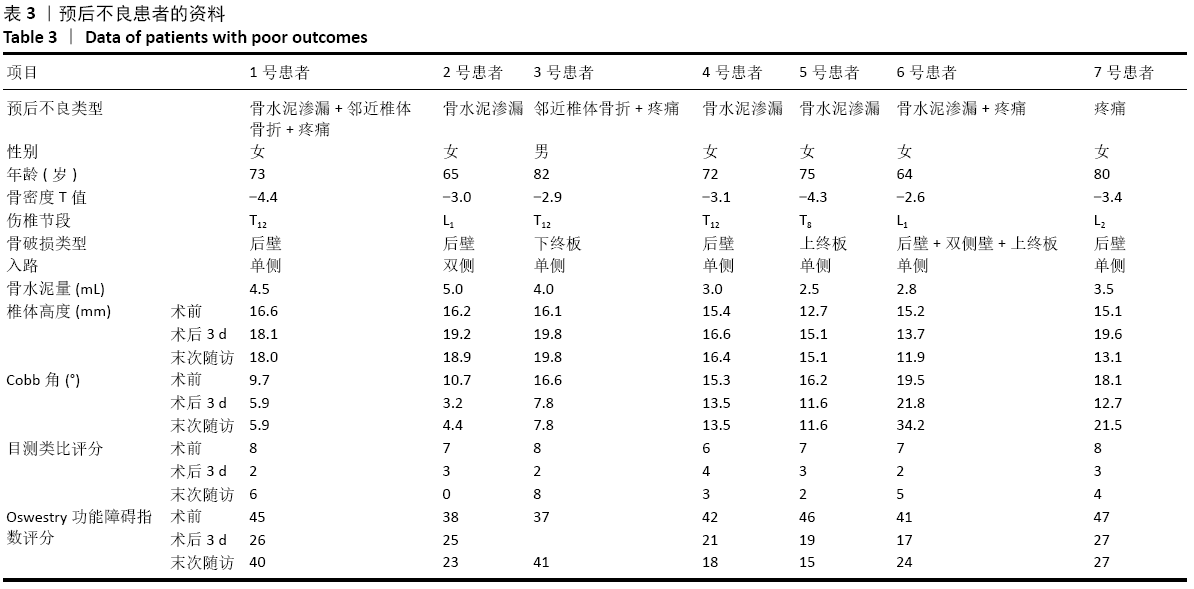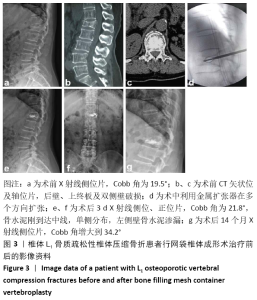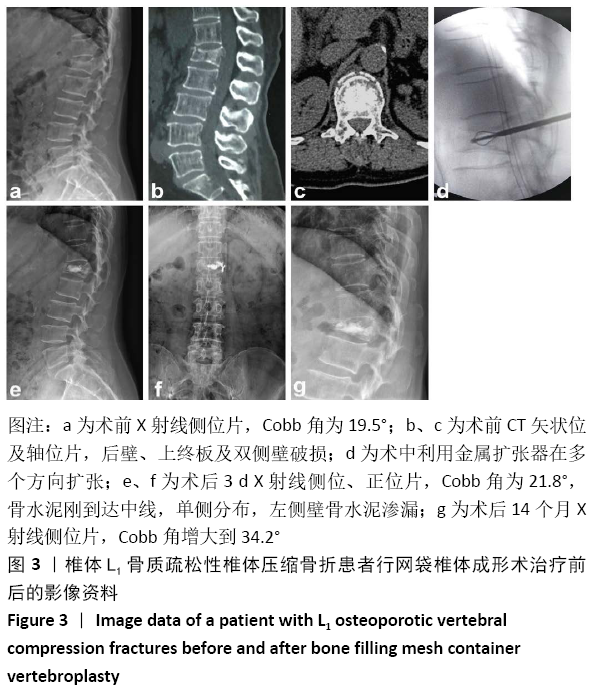[1] HUANG Y, ZHAO T, REIDLER JS, et al. The Top 100 Most-Cited Articles on Kyphoplasty and Vertebroplasty. World Neurosurg.2020;135:e435-e446.
[2] HSIEH MK, KAO FC, CHIU PY, et al. Risk factors of neurological deficit and pulmonary cement embolism after percutaneous vertebroplasty. J Orthop Surg Res. 2019;14(1):406.
[3] HUANG S, ZHU X, XIAO D, et al. Therapeutic effect of percutaneous kyphoplasty combined with anti-osteoporosis drug on postmenopausal women with osteoporotic vertebral compression fracture and analysis of postoperative bone cement leakage risk factors: a retrospective cohort study. J Orthop Surg Res.2019; 14(1):452.
[4] ZHU SY, ZHONG ZM, WU Q, et al. Risk factors for bone cement leakage in percutaneous vertebroplasty: a retrospective study of four hundred and eighty five patients. Int Orthop.2016;40(6):1205-1210.
[5] 胡敏,黄觅,胡丽丹,等.骨填充网袋经皮椎体成形术与PKP治疗骨质疏松性椎体压缩骨折的疗效比较[J].中国骨与关节损伤杂志,2020, 35(3):263-265.
[6] 王健,唐东,廖燚.骨填充网袋应用于经皮椎体成形术治疗老年骨质疏松性椎体压缩骨折的临床效果分析[J].中国临床实用医学,2020(1):32-36.
[7] PATEL A, CARTER KR. Percutaneous Vertebroplasty And Kyphoplasty. In: StatPearls. edn. Treasure Island (FL): StatPearls Publishing Copyright © 2020, StatPearls Publishing LLC,2020.
[8] LANGNER S, HENKER C. Vertebroplasty and kyphoplasty : A critical statement. Radiologe. 2020;60(2):138-143.
[9] 杨惠林,刘强,唐海.经皮椎体后凸成形术的规范化操作及相关问题的专家共识[J].中华医学杂志, 2018,98(11):808-812.
[10] 周建,周恒才,戴维享,等.单侧椎弓根旁入路骨填充网袋椎体成形术治疗骨质疏松性胸腰椎压缩骨折的疗效观察[J].中国骨与关节损伤杂志,2020,35(1):40-43.
[11] 郭旭,赵卫芹,何建昌,等.3种骨水泥成形术治疗Kümmell病的疗效观察[J].介入放射学杂志,2020,29(3):309-314.
[12] 郑吉润,李东海,李长鹏,等.骨填充网袋椎体成形术治疗老年骨质疏松性椎体压缩骨折的临床效果[J].微创医学,2019,14(6):757-759.
[13] 韩俊,黄勇.网袋椎体成形术治疗伴椎体裂隙征的骨质疏松性椎体压缩骨折[J].颈腰痛杂志,2019, 40(6):788-791.
[14] 冯方,彭毅,张晗,等.骨填充网袋椎体成形术与经皮椎体后凸成形术治疗骨质疏松性椎体爆裂骨折的比较[J].中国微创外科杂志,2020, 20(5):441-445, 450.
[15] 王智黔,赵安菊,彭智,等.骨填充网袋椎体成形术与经皮椎体后凸成形术治疗老年骨质疏松性椎体压缩骨折的疗效比较[J].中华创伤杂志, 2018,34(7):618-623.
[16] 孔庆华,秦祥德,徐媛媛,等.骨填充网袋治疗新鲜骨质疏松性椎体压缩性骨折[J].中国矫形外科杂志,2016,24(16):1528-1530.
[17] 姚珍松,陈康,江晓兵,等.网袋成形术治疗骨壁破损型复杂椎体骨折的经验[J].中国矫形外科杂志,2016,24(16):1466-1470.
[18] FAN B, WEI Z, ZHOU X, et al. Does vertebral augmentation lead to an increasing incidence of adjacent vertebral failure? A systematic review and meta analysis. Int J Surg.2016;36(Pt A):369-376.
[19] MARTIKOS K, GREGGI T, FALDINI C, et al. Osteoporotic thoracolumbar compression fractures: long-term retrospective comparison between vertebroplasty and conservative treatment. Eur Spine J.2018;27(Suppl 2): 244-247.
[20] 王清泽,袁欣华,王相,等.单节段经皮椎体成形术后继发相邻椎体骨折的危险因素[J].脊柱外科杂志,2019,17(1):6-9.
[21] DEIBERT CP, GANDHOKE GS, PASCHEL EE, et al. A longitudinal cohort investigation of the development of symptomatic adjacent level compression fractures following balloon assisted kyphoplasty in a series of 726 patients. Pain Physician.2016;19(8):E1167-E1172.
[22] 叶向阳,汤立新,程省,等.骨密度对骨质疏松性椎体压缩性骨折PKP 术后骨折再发风险的评估价值[J].中国骨质疏松杂志,2017,23(2):154-158.
[23] 李业成,张巍,张成亮,等.PVP 术后相邻椎体新发骨折的危险因素分析[J].中国骨与关节损伤杂志, 2017,32(1):25-27.
[24] 张湛金,王煜巍,陈浩,等.经皮椎体成形术与经皮椎体后凸成形术术后手术椎体再发骨折比较[J].中华骨质疏松和骨矿盐疾病杂志,2017, 10(1):20-26.
[25] 仇汪宝,荆珏华,钱军,等.经皮椎体后凸成形术后邻近椎间盘退变对邻近椎体再发骨折的影响[J]. 解放军医学院学报,2013(12):1227-1230.
[26] IBARZ E, HERRERA A, MAS Y, et al. Development and kinematic verification of a finite element model for the lumbar spine: application to disc degeneration. Biomed Res Int.2013;2013:705185.
[27] LUO J, ANNESLEY-WILLIAMS DJ, ADAMS MA, et al. How are adjacent spinal levels affected by vertebral fracture and by vertebroplasty? A biomechanical study on cadaveric spines.Spine J.2017;17(6):863-874.
[28] LIEBSCHNER MA, ROSENBERG WS, KEAVENY TM. Effects of bone cement volume and distribution on vertebral stiffness after vertebroplasty.Spine (Phila Pa 1976). 2001;26(14):1547-1554.
[29] 陆声,徐永清,张美超,等.骨质疏松椎体增强后对相邻椎体生物力学影响的有限元研究[J].中华创伤骨科杂志,2006,8(9):864-867.
[30] HEARY RF, PARVATHREDDY NK, AGARWAL N. Biomechanical Analysis of Range of Motion and Failure Characteristics of Osteoporotic Spinal Compression Fractures in Human Cadaver. Indian J Orthop. 2017;51(6): 672-676.
[31] ZHANG L, WANG Q, WANG L, et al. Bone cement distribution in the vertebral body affects chances of recompression after percutaneous vertebroplasty treatment in elderly patients with osteoporotic vertebral compression fractures. Clin Interv Aging.2017;12:431-436.
[32] 秦丰伟,张兆飞,冯永辉,等.骨水泥倒U型分布对经皮椎体成形术治疗骨质疏松椎体压缩性骨折效果的影响[J].中华骨质疏松和骨矿盐疾病杂志,2020,13(1):15-20.
[33] 李立军,朱福良,姜竹岩,等.经皮椎体后凸成形术后原手术椎体再楔形变的相关危险因素分析[J]. 中华创伤杂志,2017 33(8):724-730.
[34] TANIGAWA N, KOMEMUSHI A, KARIYA S, et al. Relationship between cement distribution pattern and new compression fracture after percutaneous vertebroplasty. AJR Am J Roentgenol.2007;189(6):W348-W352.
[35] 李亮,于学忠,隋海涛,等.伴裂隙征的骨质疏松椎体骨折椎体强化后骨水泥分布模式[J].中国组织工程研究,2013,17(26):4789-4796.
[36] FRANKL J, HENNEMEYER C. Vertebral refracture unipedicular kyphoplasty resulting in lateralized cement distribution. Vasc Interv Radiol.2015;26(12): 1906-1908.
[37] CHEN B, LI Y, XIE D, et al. Comparison of unipedicular and bipedicular kyphoplasty on the stiffness and biomechanical balance of compression fractured vetebrae. Eur Spine J.2011;20(8):1272-1280.
|
